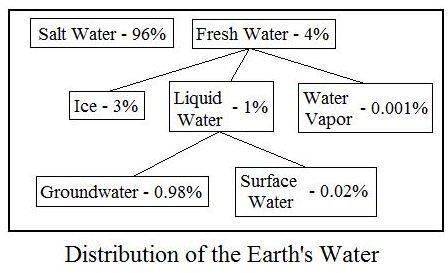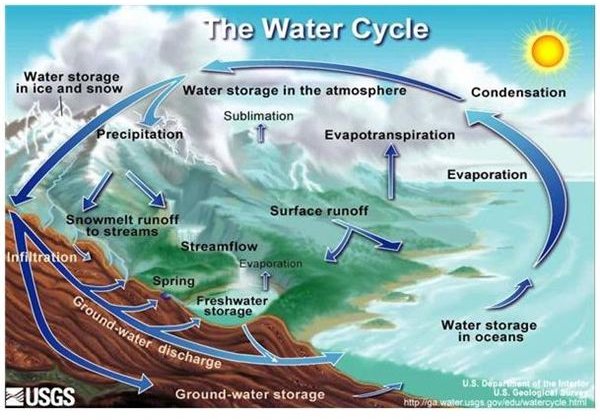Manage Water Resources Through an Understanding of Hydrology and the Water Cycle
The Water Cycle - Natural Water Movement
The word hydrology means literally, the study of water. The study of this science usually starts with gaining an understanding of the water cycle, the
natural movement of water through processes such as evaporation, precipitation, transpiration, stream flow, and stormwater runoff, at and near the earth’s surface. The water cycle diagram (above right) illustrates the processes by which the earth’s water moves around and is converted from one form to another. For more details about the water cycle, see the article, “Learn About Natural Water Movement Through a Water Cycle Diagram.”
Managing Water Resources

There are two primary types of fresh water resources, groundwater (the term used for underground water) and surface water (rivers, lakes, and streams). Although fresh surface water is only a very small part of the earth’s total water inventory, it is a very important part and is widely used for many purposes. The majority of a typical general hydrology course is devoted to the study of surface water hydrology. The diagram at the left shows information about the relative amounts of different types of the earth’s water resources.
It is worth noting at this point that there is a fundamental difference between managing water resources and managing some other natural resources, such as fossil fuels for example. Water does not get consumed as it is being used. The total inventory of water on and in the earth remains the same. It may be converted from one form to another, as for example fresh water to salt water, ice to liquid water, or water vapor in the air into stored water in plant matter through photosynthesis. In fact fresh water is continually being regenerated by a major component of the water cycle, which is evaporation from the oceans and precipitation over land. Fossil fuels on the other hand are consumed through their conversion to energy. The fossil fuels will not be regenerated unless conditions on the earth become once again as they were millennia ago, when the fossil fuels were produced from organic matter.
If water does not get consumed through its use, why are we concerned with managing our water resources? Quite simply, there is too much water at some places at some times, resulting in flooding, and there is too little water at other places at some times, resulting in drought or water shortage. Also, there is concern about contamination of our water resources through the way that we use them.
Watershed Characteristics
The watershed is a fundamental unit used in hydrology. Also known as a drainage area or river basin, a watershed is the area from which storm water runs off to a specified exit point. Identification of a watershed’s boundary and determination of some of its properties are important for several aspects of stormwater management, including design of storm sewers and storm water detention systems.
The single most important watershed characteristic is its area. Other useful characteristics of a drainage area are the slope and length of storm water runoff pathways, the ruoff coefficient and the time of concentration. The runoff coefficient is defined as the fraction of rainfall landing on a drainage area that becomes runoff. It is used in Rational Method calculation of peak stormwater runoff rate. The time of concentration is the time required for rainfall on the farthest point of the watershed to reach the exit, and is important in determining the design rainfall intensity for storm water calculations.
Storm Water Management
Management of storm water consists primarily of facilitating storm water flow, so it doesn’t build up and cause localized flooding. Structures used to accomplish this include storm sewers and/or arroyos, and perhaps storm water detention or stormwater retention facilities. Calculation of peak storm water runoff rate is needed for design of this type of facilities. The watershed characteristics identified above are used, typically with the Rational Method equation (Q = CiA) to calculate the peak storm water runoff rate, Q, based on values for the runoff coefficient, C, the watershed area, A, and the design rainfall intensity, i. For more details on Rational Method calculations, see the article, “The Rational Method for Calculation of Peak Stormwater Runoff Rate.”
References and Image Credits
References:
1. McCuen, R.S., Hydrological Analysis and Design, 2nd Ed,
2. Bengtson, H.H., Hydrology 1: Introduction/Precipitation, an online continuing education course for Professional Engineers
3. Bengtson, H.H., Rational Method Hydrologic Calculations with Excel, an online continuing education course for Professional Engineers
Image Credits:
Water Cycle Diagram - U.S. Geological Survey (USGS)
Distribution of the Earth’s Water - by H.H. Bengtson
This post is part of the series: Hydrology (The Study of Water)
Hydrology is the study of water. It includes a variety of topics on management of water resources. These include an understanding of the meaning of the term ‘100 year flood’, the steps of the water cylce, a water cycle diagram, and how to predict when a flood crest will reach Town X.
